My first ever middle school performance in appreciation of Shakespeare’s writing took place on the 28th March 2024 and was a great success. However, getting to the point where English Language & Literature (ELL) students across three grades were able to successfully coordinate and perform different Shakespearean pieces was quite a journey. In this article I will elaborate on the most involved of those journeys – grade 8 ELL students’ preparation and performance of Macbeth.
The concept of performing Macbeth originated in a plan agreed between students and teacher in the Grade 8 ELL classroom at the end of our first unit when I explained that we would be studying Shakespeare in the next unit. Students reported that they did not appreciate the Shakespeare they had previously studied and during that discussion, it became clear that they had not focused on the plays from the perspective of performance. We therefore wanted to explore the play Macbeth as a piece of performance art as well as for its literary merits. Initially there were only eight students involved and we planned to take several parts each, using Venetian masks so multiple actors could play different parts without too much audience confusion, and have the whole thing wrapped up by Christmas for our end of semester summative assessments.
However, a week into our Shakespeare unit What’s the Drama?, eight more students suddenly and without warning joined the class. This created three significant obstacles to our planned performance:
- The original plan would need to be expanded to involve the new students.
- Everything would need to be simplified as Shakespeare’s Early Modern English is not readily accessible to most students and the eight new kids had not studied English literature before.
- Due to the two points above, the timing for the performance would have to be delayed.
“That is a step
On which I must fall down or else o’erleap,
For in my way it lies.”
This led to discussion with the Grade 6 ELL teacher, whose students were going to study Shakespeare in the spring and who were interested in performing as part of their unit Is all the world a stage? We agreed to hold both Grade 6 and Grade 8 student Shakespeare performances together during Shakespeare Week, a literary festival for school children in the UK during April. This seemed to be a very appropriate date to aim for and gave my grade 8 students more time to prepare.
During their What’s the Drama? unit, Grade 8 ELL students practiced performing scenes from the play, focusing on keeping straight faces and thinking about their body language as they acted out the tragedy. This allowed them to consider some of the challenges involved in performing the play. We also practiced thinking like a director by using a ‘shoebox theatre’ to plan how a scene should look on the stage. This yielded some very encouraging results as shown in the images and video snippets below.
As part of their summative assessment the students were required to build on this work and to create a drastically reduced version of Macbeth. The aim was to reduce each of the five acts down to specific lines that had a clear function in driving the plot forward. There was a strict time limit of four minutes per act so the whole play would be under 20 minutes and therefore more realistic to perform. For this task, we retained the original idea of using masks so we could divide into five groups, with each group taking responsibility for summarizing and condensing one act of the play.
This proved to be quite challenging and by the end of the unit the status of our planned script was:
- 😀 Act 1 script ready to perform
- 😐 Act 2 too long and requiring more editing
- 😀 Act 3 ready to perform
- 😳 Act 4 missing because the students had prepared the wrong act and we instead had two different versions of act 3
- 👿 Act 5 missing because that group did not complete the work
If we should fail—
We fail?
But screw your courage to the sticking place
And we’ll not fail.

Fortunately, before the Spring Festival holiday started, we had nearly two weeks to fix acts two, four and five and to start planning the final performance. Reflecting on the successes and failures of the summative assessment results led to several important decisions such as the appointment of a student director, the necessity for clear backgrounds and written labels for scenes, the importance of gesture, and the abandonment of the masks concept.





By the end of that two-week period, we had agreed a script and decided on the roles each student would play. This was largely agreed by voting, except for Lady Macbeth who volunteered. The actor playing Macbeth was chosen for his speaking confidence, natural swagger and relative size. Physical size proved to be an unexpectedly important concern for some of the roles because, in one of our practice sessions, one group had performed with a tall, strong Lady Macbeth towering over a shorter, skinnier Macbeth. Whilst this could be appreciated as way of interpreting some of the symbolism surrounding manliness in the play and the relative power relations between the two characters in certain scenes, it proved confusing for the audience, so we selected the taller boys for the warrior roles. Having made these casting decisions, the students were then able to start reviewing their lines and their holiday homework was to identify any lines that they felt could be deleted to further shorten our version of the play.
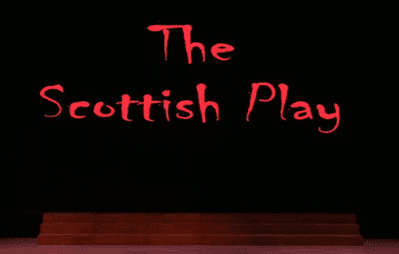
After the holiday we were hit by several misfortunes. Perhaps we should have seen this coming because Macbeth is known among the performing arts community to be cursed. Indeed, acting tradition dictates that we should have been referring to our project as ‘the Scottish play’ and not mentioning the name Macbeth at all! These misfortunes were:
- The student director left our school, which necessitated appointment of new directors and a slight rearrangement of the casting roles.
- I almost lost my voice due to an infection, which made helping with the directing and organizing in rehearsals very difficult.
- We had five more students added to our class who had not previously studied English literature and had missed the unit on Macbeth, but who now needed to be involved in the performance.
These setbacks compounded the already big challenge of practicing the performance alongside studying our new unrelated unit. To make things a little easier, we appointed a narrator who could take some of the lines from the actors. I prepared a simple PowerPoint presentation to keep track of the scenes. This developed as students made recommendations during our rehearsals. I also prepared some props so the students could stick their lines on the back of those and we could therefore practice without them having to carry pieces of flapping A4 paper around.
The main challenge during rehearsals was to ensure students knew when to go on and off the stage to reduce the time of the performance to 20 minutes or less. Many students tended not to pay attention while their peers were performing so needed a lot of prompting to get on and off the stage at the correct times. The first full rehearsal took well over an hour so significantly more practice was needed. However, we were actually studying a different text in class, having finished the unit on Macbeth before Christmas. As one student rightly pointed out in their end of unit reflection, “we are doing TOOOOO MUCH Macbeth in this unit!”
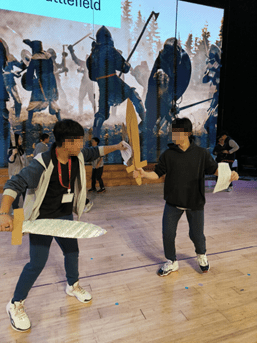
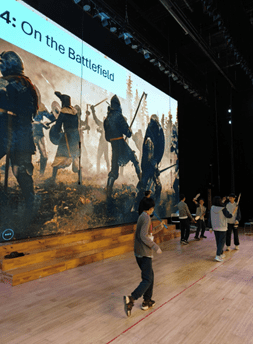
Battle scene choreography practice.
It was then that things really escalated. The head of the English department started promoting the Shakespeare Week event and it came to the attention of school leaders who asked for it to be postponed (i.e. a post-Shakespeare Week performance) so they could attend and enjoy the show. The main advantages of this were the assistance of Mr. Alex from the Performing Arts department (thanks Mr. Alex!) and the sudden appearance of a budget, so we could purchase some rudimentary costumes (the witches showed great initiative by sorting out their own costumes). This also meant more time given over to practice, but a week before the proposed date of the performance we were still at around 45 minutes and a lot of improvements were necessary. I made a few emergency cuts to our script where scenes caused confusion among the actors, giving our reliable narrator a little more work.
Finally, the big day arrived, and all the students achieved a personal best for the performance of their parts and their timing was down to just over 22 minutes, so not too far off our original target of 20 minutes. The performance on the day was very successful as you can see in the pictures below.
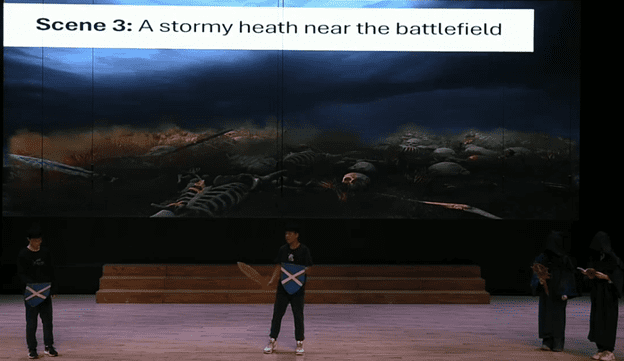
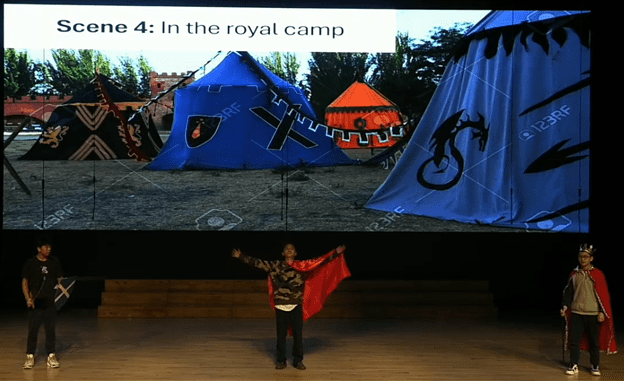
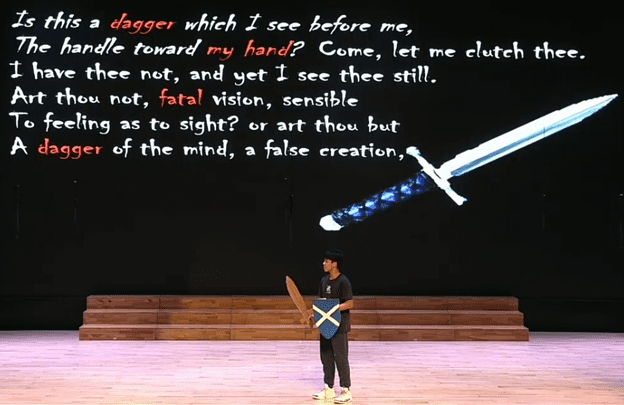
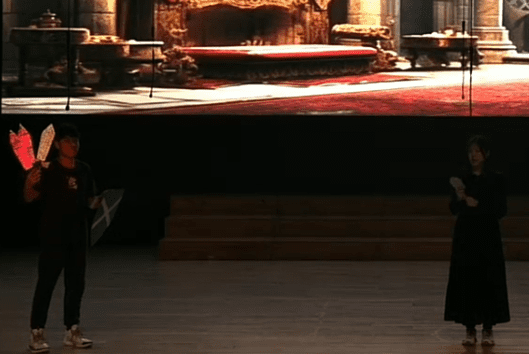

Double, double toil and trouble;
Fire burn, and cauldron bubble.
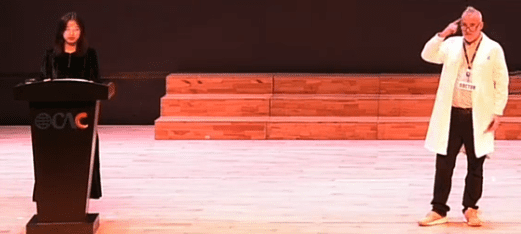
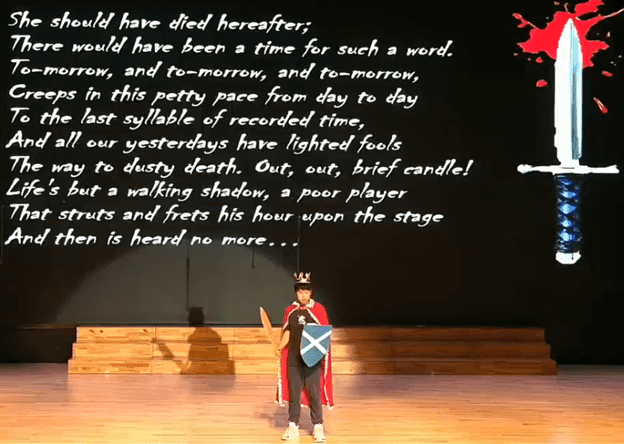
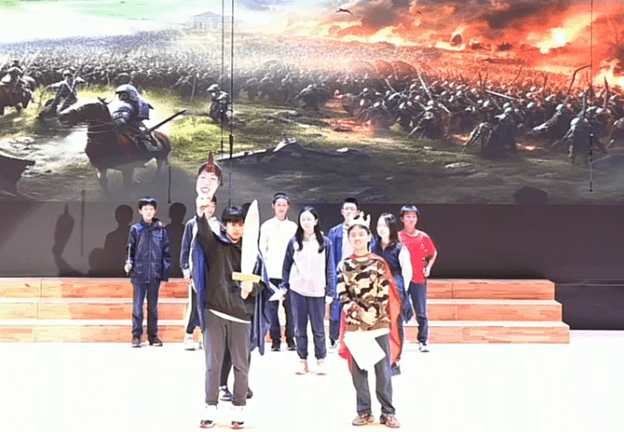
When the curtains closed, backstage there was a palpable sense of having achieved something as team 😀
The students reported that they especially liked the second apparition, Malcolm’s announcement that he was the Prince of Cumberland, and Macduff’s cry of “O horror, horror, horror!” The audience also seemed to enjoy the performances, even though it is doubtful that many understood what they were listening to.
My favourite part of the play was Act IV Scene I where the witches perform the famous rhyme “Double, double toil and trouble; Fire burn, and cauldron bubble.” In this scene, the witches’ costumes, movements, props, the background and the eerie green lighting all combine to create the intended creepy effect.
O horror, horror, horror!
In the immediate aftermath of the performance, the actor who played Macbeth was interviewed, during which he declared, “I told Dr Terrett that I don’t understand Shakespeare’s Early Modern English. I don’t understand what I’ve been saying. I just read my lines with passion!” As the literature teacher, I admit it is a little disappointing to hear such comments from the students. I conclude that careful reflection about our classroom study is necessary and that we might need to spend more time interpreting the words of the play during our Shakespeare lessons next year. However, I suppose by putting in context with all the obstacles we had faced putting this performance together, I can take some solace from the fact that he had obviously been paying sufficient attention in class to be able to classify Shakespeare’s work as Early Modern English. Besides, with a little prompting, he and other interviewees were at least able to articulate the basics of the play’s plot.
More importantly, the students had succeeded in our initial aim of lifting Shakespeare off the page and it was clear that they had learned a lot and gained confidence through all the practice and preparation for the performance. As another student reflected, “about Macbeth, we didn’t learn the contents of it in this semester, we are learning how to perform the play…the good thing is that we were all doing a Jim-Dandy job in acting: witches’ amazing performance, [Macbeth] and [Banquo]’s dialogue, etc.”

It was very much a student-led project. They adapted the script. They made the major decisions about how the performance was organized, where to stand on stage and how to use lighting. They directed and acted the play. This is definitely a great achievement worthy of being celebrated.
Now the idea has been established, I look forward to finding out how next year’s ELL students will take up the challenge of performing some Shakespeare!
We will perform in measure, time, and place.
So thanks to all at once and to each one…








